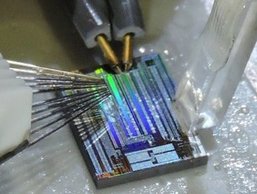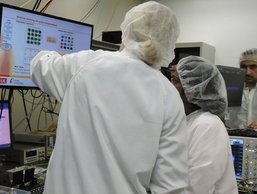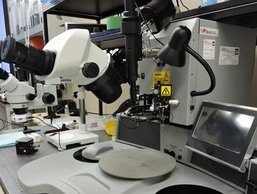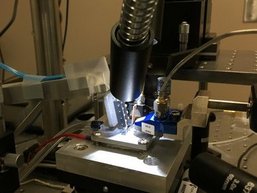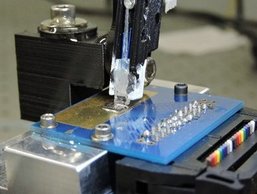Optical Communications Laboratory
The Optical Communications Laboratory is the result of an initiative by professors Sophie LaRochelle, Leslie Rusch and Wei Shi aimed at providing Université Laval with state-of-the-art equipment in optical communications technologies. The entity includes 13 laboratories covering a total area of 376 m2.
It acts as the backbone of a global network and is widely used for the provision of Internet services globally (local, city and long distance), in data centres and in cloud computing centres.
The lab maintains its research and innovation efforts in the following areas:
For more information on the Optical Communications Laboratory: Optical Communications Laboratory (OCL) - OCL (ulaval.ca)
Optical Engineering Research Laboratory
Led by Prof. Simon Thibault, PhD, Eng., the Optical Engineering Research Laboratory (LRIO) of Université Laval is the only Canadian research laboratory to offer graduate and postgraduate training in optical design. Several research projects are carried out on theoretical and experimental concepts for the development of solutions in various fields of modern optics applications including instrumentation for astronomy and space exploration, medical applications, security and surveillance, remote sensing, computer vision, industrial inspection, military systems and lighting.
This laboratory is based on 4 research axes in addition to participating in the realization of astronomical instrumentation projects.

The Metrology and Optical Manufacturing Axis
The laboratory has privileged access to the Advanced Optical Fabrication Infrastructure (AOFI), allowing the precision machining of various optical components, as well as an assembly and test laboratory for the prototyping of complex systems.
For more information on Advanced Optical Fabrication Infrastructure: AOFI - COPL (ulaval.ca)

The Optical Design Axis and Wide-Angle Systems
This research axis focuses on improving the optical design processes of imaging and illumination systems, including wide-angle systems.

The Non-Paraxial Focus and Propagation Axis
This research axis explores various models aimed at studying the properties of light in exotic conditions.

The Non-Imaging Photonic Axis
Within this axis are developed innovative and creative technologies for a range of innovative applications in multidisciplinary fields such as solar energy, remote sensing, lighting and environmental sciences.
To achieve its mission, this laboratory has acquired and developed a series of latest generation equipment such as:
- An Optikos LensCheck VIS test bench
- A Trioptics OptiSpheric, OptiSurf and OptiCentric test bench
- A Point Source Microscope Optical Perspective Group
- A Zygo Mark GPI-XPS interferometer
- A Zygo Verifire HD interferometer
- An ESDI Intellium H2000 interferometer
- A Stellarnet inc green-wave model GW-Vis spectrometer
- An Agilent Technologies model cary 5000 UV-VIS-NIR spectrometer
- A Dektak 150 profilometer Olympus STM6 inspection microscope
- An SEM/FIB microscope FEI model Quanta 3D FEG
- A Veeco Dimension V scanning microscope
- A Leybold thin film deposition system
- A SYRUS-PRO-710 Advanced Plasma System (APS)
- An Intlvac Nanochrome System thin film deposition system
- A thermal deposition system
- An Electron Beam Physical Vapor Deposition (EBPVD) system
- A metricon prism coupler mline model 2010/M
- A nanoform 250 Ultra Precision Machining System for diamond turning and milling
- A Talysurf PGI Freeform Surface Profiler
- A Zeeko IRP200 Ultra-Precision Polishing Machine
For more information: LRIO - Optical Engineering Research Laboratory (ulaval.ca)
Photo-Inscription Laboratory by Femtosecond Laser
The femtosecond laser photo-registration laboratory is an expertise of Université Laval divided into 3 distinct research groups. The instigators of this group are professors Réal Vallée and Martin Bernier.
The Laser-Matter Interaction Laboratory
This intensive research environment is dedicated to understanding the interaction between matter and high-power laser irradiation as well as the registration of three-dimensional photonic sensors and circuits using femtosecond lasers.
The main equipment that composes it are:
- A Clark femtosecond laser chain
- A RegA femtosecond laser chain
- A Phasics quantitative phase imaging system
- A waveguide transmission analysis system
The Bragg Grating Inscription Laboratory
This laboratory focuses its research on the inscription of periodic structures in different types of optical fibers and transparent materials (based on silica or exotic glasses) with the aim of developing innovative photonic components.
To optimize its work, this group is distinguished by equipment such as:
- A Coherent-Astrella laser chain (4mJ, 1 kHz, 30fs)
- An automated Bragg grating registration setup
- An interferometric assembly
- Spectral characterization systems operating in the 350-5500nm range
- Fiber Bragg grating modeling software
The Fiber Optic Laser Development Laboratory
The layout of this research space is entirely dedicated to the study and development of fiber optic lasers and amplifiers, continuous or pulsed, by exploiting the energy transitions of materials from the rare earth family (Erbium, Dysprosium, Holmium, etc.) and parametric gain.
The equipment that supports the research work are:
- A CO2 Merger
- A Vytran Merger
- A plasma fusion machine
- High-power diode pumping systems
- A spectral characterization system operating from visible to mid-infrared
Glass and Vitroceramics Synthesis Laboratory
This laboratory is dedicated to the development of glasses and glass-ceramics, strategically synthesized in order to provide them with unique characteristics, for their basic use in photonic optics. These advanced photonic materials are developed to enable:
- Low light absorbance by more specifically targeting the mid-infrared spectral region.
- The exploitation of certain nonlinear behaviors
- The exploitation of magneto- and electro-optical properties
- Achievement of specific physical and mechanical characteristics
- Their use as electromagnetic waveguides, for example, in the form of optical fibers
- The manufacture of special optical fibers
Besides their use in academic research (for example, laser cooling) or guided optics through our technology platform for the production of optical fibers, these materials have applications in various fields, such as telecommunications, the environment ( for example, optical sensors) and biomedical.
Laboratory of Hybrid and Functional Materials
This laboratory is dedicated to the design and development of materials with exceptional optical and mechanical characteristics. By developing hybrid, conjugate or even multistructured materials, it is possible to achieve capacities that go beyond the limits of the components conventionally used in optics and photonics. The laboratory is equipped with the latest generation equipment for the synthesis and functionalization of organic glasses, nanoparticles and biomaterials, in highly controlled environments.

